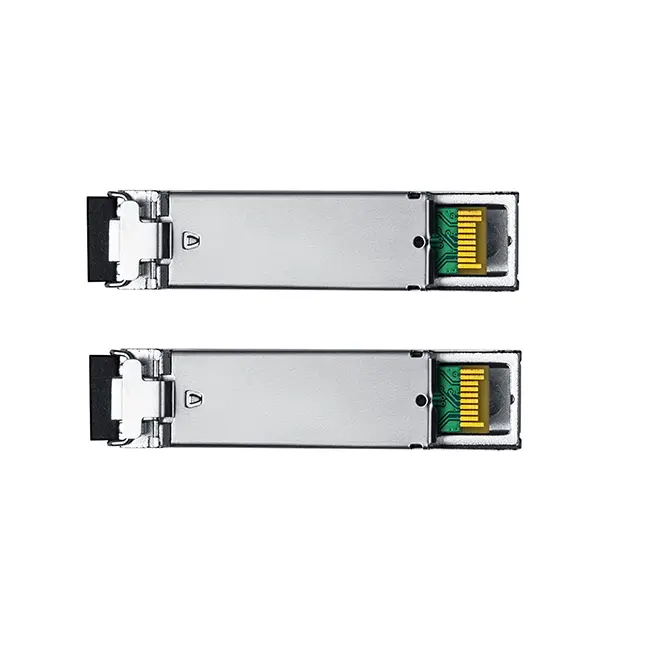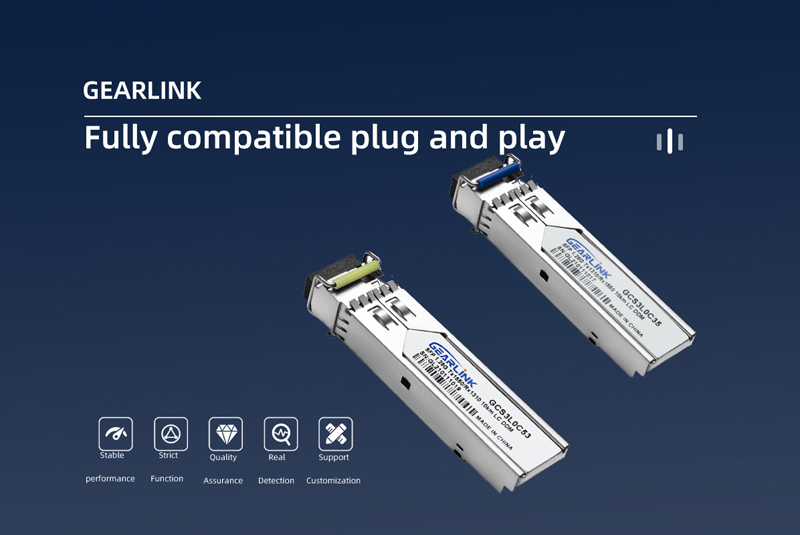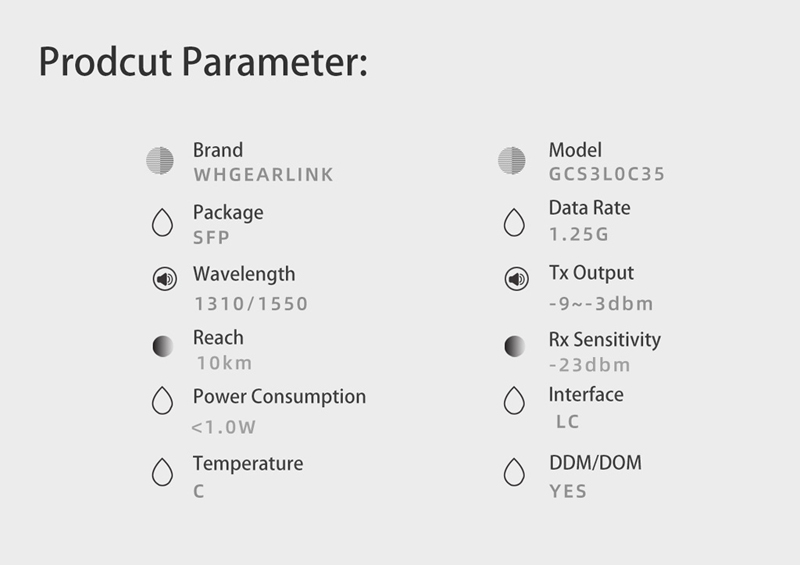
Gearlink’s SFP-GE-BX SFP transceiver is compatible with the Small Form Factor Pluggable Multi-Sourcing Agreement (MSA). The 1310nm 1490nm sfp transceiver consists of five sections: the LD driver, the limiting amplifier, the digital diagnostic monitor, the 1310nm FP laser(the 1490nm DFB laser), and the PIN/TIA. The module data link up to 10km in 9/125um Single-mode fiber.
This sfp 1310 1490 transceiver meets the Small Form Pluggable (SFP) industry-standard package utilizing an integral LC-Bi-directional optical/sfp bidi interface connector. An enhanced Digital Diagnostic Monitoring Interface.
compliant with SFF-8472 has been incorporated into the transceiver. It allows real-time access to the transceiver operating parameters such as transceiver temperature, laser bias current, transmitted optical power, received optical power, and transceiver supply voltage by reading a built-in memory with an I²C interface.
The optical output can be disabled by an LVTTL logic high-level input of Tx Disable, and the system also can disable the module via I²C. Tx Fault is provided to indicate the degradation of the laser. Loss of signal (LOS) output is provided to indicate the loss of an input optical signal of the receiver or the link status with the partner. The system can also get the LOS (or Link)/Disable/Fault information via I²C register access.
Simple to Use: Simple installation, plug and play, and fully hot-pluggable. With 1.25G SFP 1310 1490 ports, it is commonly used for the fiber switches, routers, NICs, servers, as well as other fiber optic equipment.
Superior DDM Function- DDM helps in monitoring critical information about the status of the transceivers' transmission and reception signals in real-time to identify potential issues.
| GLC-BX-U20 | 1000BASE-BX SFP BIDI 1310nm-TX/1490nm-RX 20km |
| GLC-2BX-U | 1000BASE-BX10-U TX:1310nm/RX:1490nm 10km CSFP |
| GLC-BX-U | 1000BASE-BX10-U SMF TX:1310nm/RX:1490nm 10km SFP |
| EX-SFP-GE10KT13R14 | 1000Base-BX-U TX:1310nm/RX:1490nm 10km BiDi SFP |
| SFP-GE10KT13R14 | 1000Base-BX-U SMF TX:1310nm/RX:1490nm 10km SFP BIDI |
| E1MG-BXU | 1000BASE-BX10-U TX:1310nm/RX:1490nm 10km SFP |
| 10056 | 1000Base-BX-U SMF TX:1310nm/RX:1490nm 10km SFP |
| JD098B | 1000BASE-BX10-U TX:1310nm/RX:1490nm 10km SFP |
| JD098A | 1000BASE-BX10-U SMF TX:1310nm/RX:1490nm 10km SFP |
| SFP-GE-LX-SM1310-BIDI | 1000BASE-BX10-U TX:1310nm/RX:1490nm 10km SFP |
Parameter | Symbol | Min | Typ. | Max | Unit |
Bit Rate | BR | 1.25 | Gb/s etc | ||
Max.Supported Link Length | Max | 10 | km |
Parameter | Symbol | Min | Typ. | Max | Unit | Ref. |
Storage Temperature | TS | -40 | 85 | ºC | ||
Storage Ambient Humidity | HA | 5 | 95 | % | ||
Power Supply Voltage | VCC | -0.5 | 4 | V | ||
Signal Input Voltage | -0.3 | Vcc+0.3 | V | |||
Receiver Damage Threshold | +3 | dBm | ||||
Lead Soldering Temperature/Time | Told | 260/10 | ºC/sec | Note 1 | ||
Lead Soldering Temperature/Time | Told | 360/10 | ºC/sec | Note 2 |
Notes:
1. Suitable for wave soldering.
2. Only for soldering by iron.
The single-fiber optical transceiver realizes data transmission through one fiber core. Data transmission and reception are realized through different optical wavelengths in one optical fiber. Single-fiber optical transceiver s are generally used in pairs. The A/B side parameters are reversed. The A/B side parameters are reversed. Example A terminal optical transceiver (Tx 1310nm/Rx 1490). B-end optical transceiver (Tx 1490nm/Rx 1310)


The single-fiber bidirectional transceiver is what we often call the BIDI optical transceiver . There is only one connector connected to one optical fiber for transmission. It is very simple to distinguish whether it is a BIDI optical transceiver , that is, the BIDI optical transceiver has only one interface, while the dual-fiber optical transceiver has two interfaces.
Single-fiber optical transceiver is also called single-fiber bidirectional optical transceiver , which is also what we often call BIDI optical transceiver . Only one connector connects one fiber for transmission. It is very simple to distinguish whether it is a BIDI optical transceiver , that is, the BIDI optical transceiver has only one interface, while the dual-fiber optical transceiver has two interfaces.
First of all, the transmission rate and distance must be the same. For example, if the same 10 Gigabit BIDI is used, generally the wavelength of the receiving end and the transmitting end of the opposite end should be the same. For example, one side uses Tx1310/Rx1550 10KM. Then the other side will use Tx1550/Rx1310 10km. Generally, this kind of BIDI is bought and used in pairs.